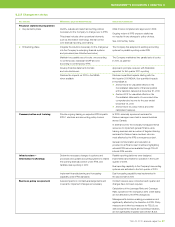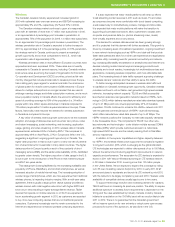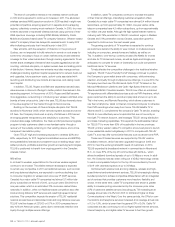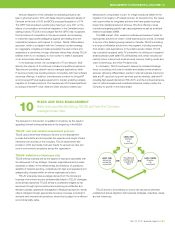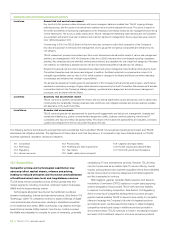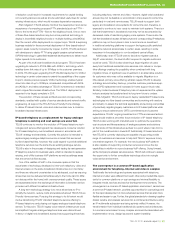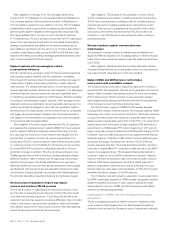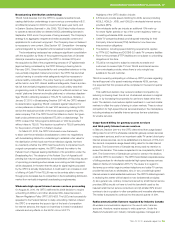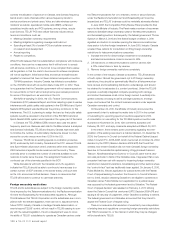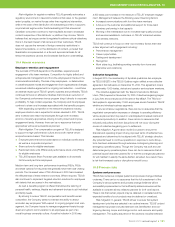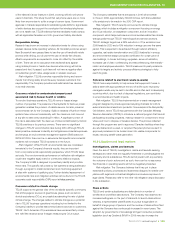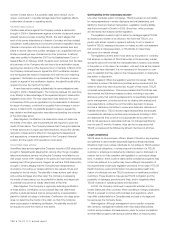Telus 2010 Annual Report Download - page 101
Download and view the complete annual report
Please find page 101 of the 2010 Telus annual report below. You can navigate through the pages in the report by either clicking on the pages listed below, or by using the keyword search tool below to find specific information within the annual report.
TELUS 2010 annual report . 97
MANAGEMENT’S DISCUSSION & ANALYSIS: 10
provision capacity and maintain high service levels in the face of growing
demand and pace of innovation of data devices.
Risk mitigation: TELUS built an extensive wireless network based
on HSPA+ technologies and is currently implementing HSPA+ dual-cell
technology. The HSPA+ network positions TELUS to meet the capacity
demands and challenges in the foreseeable future.
In addition to the superior capabilities and higher capacity delivered
by HSPA+, the infrastructure supporting TELUS’ network facilitates
the future migration to LTE wireless technologies that are expected
to further increase network capacity and speed. TELUS’ investments in
IP networks, IP/fibre cell-site backhaul and a software-upgradeable radio
infrastructure are expected to greatly facilitate rapid introduction of
LTE when this ecosystem reaches maturity. LTE technologies that TELUS
began testing in 2010 are expected to deliver download speeds of up
to 100 Mbps, while at the same time introducing significant improvements
in performance. These improvements are expected to increase network
capacity, enhance performance, reduce delivery costs per megabyte
of data, enable richer multimedia applications and services, and deliver
a superior subscriber experience.
Fast growth of wireless data volumes requires optimal and efficient
utilization of TELUS’ spectrum holdings. Deployment of HSPA+ tech-
nology, the eventual launch of LTE technology and development of a
capacity management toolkit aim to achieve efficient utilization of TELUS’
spectrum holdings and position TELUS to meet increasing levels of data
traffic. TELUS has developed a spectrum strategy to further strengthen
its ability to deliver the mobile Internet to Canadians in the future and
intends to participate in upcoming spectrum auctions. If the Company
is successful in its bids, the additional spectrum would provide additional
capacity and mitigate risk of increasing data traffic, as well as allow
for economic deployment of LTE services in rural coverage areas.
Transition to other 4G wireless technologies could be
slowed by delays in development of an LTE ecosystem
The timing for the standardization and development of LTE technologies
aligns with the need for additional network capacity required to address
the surging demand for wireless data. However, just as with any other
new wireless technology, there remain significant challenges that the
industry needs to overcome in the first few years following standardization,
and prior to being able to successfully support large LTE deployments.
These include both technological and business challenges: harmonization
of global spectrum, intellectual property rights, support for voice and
SMS, interoperability, device availability, technology maturity, operational
readiness and costs. The wireless industry appears committed to
making LTE the worldwide technology standard, as evidenced by its
R&D, testing and interoperability efforts. Despite this, there remains
a risk that the development of a robust LTE ecosystem may experience
some delays; these delays, against a background of surging data
traffic demand, represent a risk for the operator.
Risk mitigation: TELUS’ implementation of LTE technologies will
primarily be driven by a business case that is based on the launch of
TELUS’ HSPA+ network, and as such, TELUS’ focus remains on the
revenue growth opportunities that this new network enables. In support
of this, TELUS’ wireless network is ready to evolve through software
upgrades to support enhancements in HSPA+ that improve performance,
capacity and speed. In parallel, and complementary to the evolution
of HSPA+, TELUS is developing a comprehensive capacity management
toolkit that will help address traffic growth challenges prior to the
introduction of LTE, and which also is expected to complement LTE
once it is deployed.
The Company expects its overall wireless and wireline capital intensity
level, excluding any capital that may be required for wireless spectrum
auctions, to be approximately 17% of consolidated revenues in 2011.
However, there is the risk that TELUS’ future wireless capital expenditures
may be higher than those recorded historically in order to meet ongoing
technology investments, including investments in HSPA+ dual-cell and
LTE technologies.
Technology evolution
Although LTE is part of the technology evolution of a mature HSPA+
platform, some operators in Canada or elsewhere may seek to accel-
erate the deployment of LTE, which could influence the diversion
of resources from HSPA+ development by the vendor and operator
communities, and could affect TELUS’ technology evolution plan.
Risk mitigation: As common and continual practice, TELUS optimizes
capital investments to enable positive payback periods and good
flexibility to consider future technology evolutions. Certain capital invest-
ments, such as towers, leasehold improvements and power systems,
are technology-agnostic. TELUS has a migration initiative underway
to strategically move certain CDMA and Mike subscribers to high-speed
data devices, thereby providing the potential to increase utilization of
data services and stabilize revenue. TELUS expects to leverage the
economies of scale and handset variety with the HSPA+ device porfolio,
while continuing to take advantage of both the CDMA and iDEN
device portfolios.
The agreement with Bell Canada to jointly build out an HSPA network
provided the means for TELUS to better manage its capital expenditures
and more quickly deliver a commercial network than could otherwise
have been accomplished. TELUS’ continued collaboration with Bell
Canada is expected to provide cost savings beyond the initial network
build and flexibility to invest in service differentiation.
TELUS maintains a close liaison with its network technology suppliers
and operator partners to influence and benefit from developments in
iDEN, CDMA and HSPA technologies. By contracting its suppliers to
provide technology solutions that are amenable to future advancements
like LTE, TELUS can mitigate the operational disruption during tech-
nology transitions. Fundamental to TELUS’ strategy is the reuse and
redeployment of application servers and network elements that are
access-agnostic, such as messaging into the latest radio access
technology. This enables TELUS to invest in radio-based technologies
as they evolve and as required, without the need to replace these
application servers.
Subscriber demand for data may challenge wireless
networks and is expected to be accompanied by
decreasing unit-pricing
The demand for wireless data services has been growing at unprece-
dented rates and it is projected that this demand will further accelerate,
driven by increases in: broadband penetration; the need for personal
connectivity and networking; affordability of smartphones and high-usage
data devices (such as the iPhone, mobile Internet keys and tablets),
and machine-to-machine data applications; increasingly rich multimedia
services and applications; and increasing wireless competition that
may include more affordable data plans. In addition, given the highly
competitive wireless business environment in Canada, it is expected that
wireless data revenues will grow more slowly than traffic demand. This
gap between traffic and revenue growth represents one of the most
significant challenges for operators in this mobile Internet era.
In this mobile Internet era, accelerating data traffic levels represent
a growing challenge to the current mobile network’s ability to adequately


